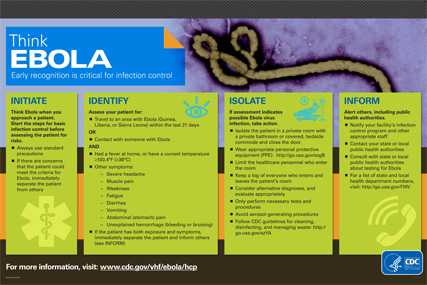When Caring for Patients Under Investigation (PUIs) or Patients with Confirmed Ebola Virus Disease (EVD)
The recommendations on this page are no longer in effect and will not be updated.
Think Ebola: Early recognition is critical for infection control:
Initiate
Think Ebola when you approach a patient. Start the steps for basic infection control before assessing the patient for risks.
- Always use standard precautions.
- If there are concerns that the patient could meet the criteria for Ebola, immediately separate the patient from others.
Identify
Assess your patient for
- International travel
OR
- Contact with someone with EVD.
AND
- Had a fever at home, or have a current temperature ≥100.4°F (≥38°C).
- Other symptoms are
- Severe headache
- Muscle pain
- Weakness
- Fatigue
- Diarrhea
- Vomiting
- Abdominal (stomach) pain
- Unexplained hemorrhage (bleeding or bruising)
- If the patient has both exposure and symptoms, immediately separate the patient and inform others (see INFORM).
Isolate
If assessment indicates possible Ebola virus infection, take action.
- Isolate the patient in a private room with a private bathroom or covered, bedside commode and close the door.
- Wear appropriate personal protective equipment (PPE).
- Limit the healthcare personnel who enter the room.
- Keep a log of everyone who enters and leaves the patient’s room.
- Consider alternative diagnoses, and evaluate appropriately.
- Perform only necessary tests and procedures.
- Avoid aerosol-generating procedures.
- Follow CDC guidelines for cleaning, disinfecting, and managing waste.
Inform
Alert others, including public health authorities.
- Notify your facility’s infection control program and other appropriate staff.
- Contact your state or local public health authorities.
- Consult with state or local public health authorities about testing for EVD.
- See list of state and local health department numbers.
- Page last reviewed: March 22, 2016
- Page last updated: December 29, 2015
- Content source:




 ShareCompartir
ShareCompartir
